engine INFINITI QX60 2019 Owner's Manual
[x] Cancel search | Manufacturer: INFINITI, Model Year: 2019, Model line: QX60, Model: INFINITI QX60 2019Pages: 540, PDF Size: 6.41 MB
Page 480 of 540
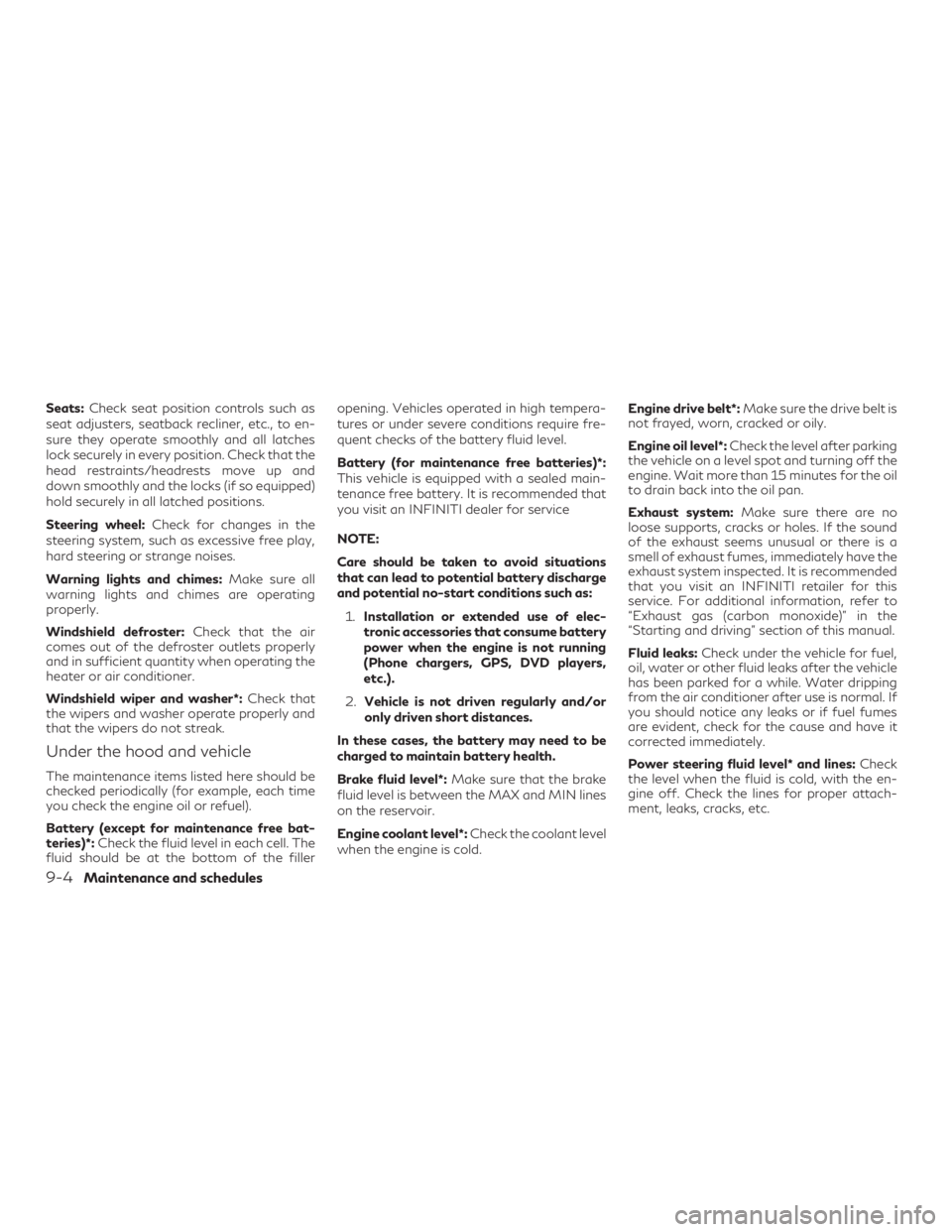
Seats:Check seat position controls such as
seat adjusters, seatback recliner, etc., to en-
sure they operate smoothly and all latches
lock securely in every position. Check that the
head restraints/headrests move up and
down smoothly and the locks (if so equipped)
hold securely in all latched positions.
Steering wheel: Check for changes in the
steering system, such as excessive free play,
hard steering or strange noises.
Warning lights and chimes: Make sure all
warning lights and chimes are operating
properly.
Windshield defroster: Check that the air
comes out of the defroster outlets properly
and in sufficient quantity when operating the
heater or air conditioner.
Windshield wiper and washer*: Check that
the wipers and washer operate properly and
that the wipers do not streak.
Under the hood and vehicle
The maintenance items listed here should be
checked periodically (for example, each time
you check the engine oil or refuel).
Battery (except for maintenance free bat-
teries)*: Check the fluid level in each cell. The
fluid should be at the bottom of the filler opening. Vehicles operated in high tempera-
tures or under severe conditions require fre-
quent checks of the battery fluid level.
Battery (for maintenance free batteries)*:
This vehicle is equipped with a sealed main-
tenance free battery. It is recommended that
you visit an INFINITI dealer for service
NOTE:
Care should be taken to avoid situations
that can lead to potential battery discharge
and potential no-start conditions such as:
1. Installation or extended use of elec-
tronic accessories that consume battery
power when the engine is not running
(Phone chargers, GPS, DVD players,
etc.).
2. Vehicle is not driven regularly and/or
only driven short distances.
In these cases, the battery may need to be
charged to maintain battery health.
Brake fluid level*: Make sure that the brake
fluid level is between the MAX and MIN lines
on the reservoir.
Engine coolant level*: Check the coolant level
when the engine is cold. Engine drive belt*:
Make sure the drive belt is
not frayed, worn, cracked or oily.
Engine oil level*: Check the level after parking
the vehicle on a level spot and turning off the
engine. Wait more than 15 minutes for the oil
to drain back into the oil pan.
Exhaust system: Make sure there are no
loose supports, cracks or holes. If the sound
of the exhaust seems unusual or there is a
smell of exhaust fumes, immediately have the
exhaust system inspected. It is recommended
that you visit an INFINITI retailer for this
service. For additional information, refer to
“Exhaust gas (carbon monoxide)” in the
“Starting and driving” section of this manual.
Fluid leaks: Check under the vehicle for fuel,
oil, water or other fluid leaks after the vehicle
has been parked for a while. Water dripping
from the air conditioner after use is normal. If
you should notice any leaks or if fuel fumes
are evident, check for the cause and have it
corrected immediately.
Power steering fluid level* and lines: Check
the level when the fluid is cold, with the en-
gine off. Check the lines for proper attach-
ment, leaks, cracks, etc.
9-4Maintenance and schedules
Page 481 of 540
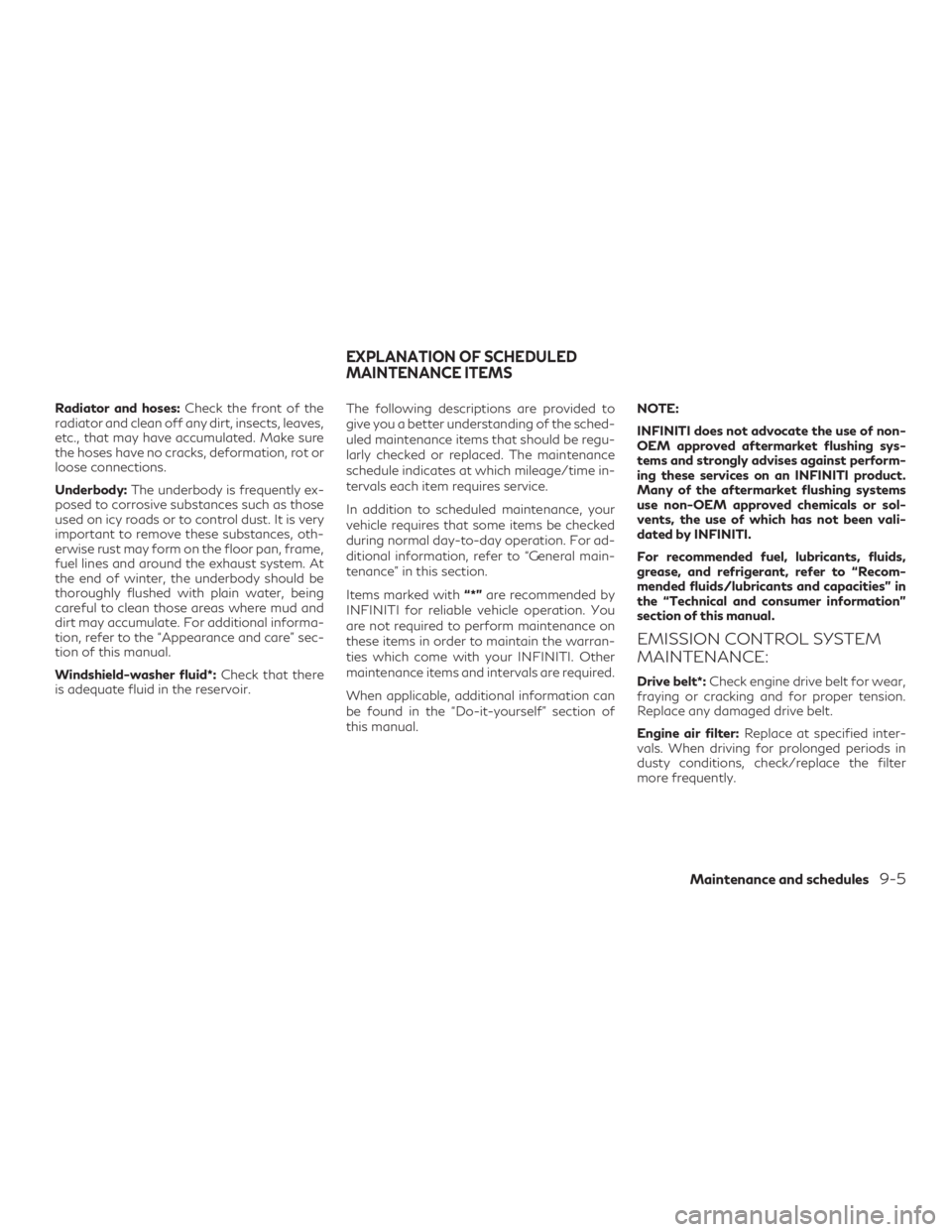
Radiator and hoses:Check the front of the
radiator and clean off any dirt, insects, leaves,
etc., that may have accumulated. Make sure
the hoses have no cracks, deformation, rot or
loose connections.
Underbody: The underbody is frequently ex-
posed to corrosive substances such as those
used on icy roads or to control dust. It is very
important to remove these substances, oth-
erwise rust may form on the floor pan, frame,
fuel lines and around the exhaust system. At
the end of winter, the underbody should be
thoroughly flushed with plain water, being
careful to clean those areas where mud and
dirt may accumulate. For additional informa-
tion, refer to the “Appearance and care” sec-
tion of this manual.
Windshield-washer fluid*: Check that there
is adequate fluid in the reservoir. The following descriptions are provided to
give you a better understanding of the sched-
uled maintenance items that should be regu-
larly checked or replaced. The maintenance
schedule indicates at which mileage/time in-
tervals each item requires service.
In addition to scheduled maintenance, your
vehicle requires that some items be checked
during normal day-to-day operation. For ad-
ditional information, refer to “General main-
tenance” in this section.
Items marked with
“*”are recommended by
INFINITI for reliable vehicle operation. You
are not required to perform maintenance on
these items in order to maintain the warran-
ties which come with your INFINITI. Other
maintenance items and intervals are required.
When applicable, additional information can
be found in the “Do-it-yourself” section of
this manual. NOTE:
INFINITI does not advocate the use of non-
OEM approved aftermarket flushing sys-
tems and strongly advises against perform-
ing these services on an INFINITI product.
Many of the aftermarket flushing systems
use non-OEM approved chemicals or sol-
vents, the use of which has not been vali-
dated by INFINITI.
For recommended fuel, lubricants, fluids,
grease, and refrigerant, refer to “Recom-
mended fluids/lubricants and capacities” in
the “Technical and consumer information”
section of this manual.
EMISSION CONTROL SYSTEM
MAINTENANCE:
Drive belt*:
Check engine drive belt for wear,
fraying or cracking and for proper tension.
Replace any damaged drive belt.
Engine air filter: Replace at specified inter-
vals. When driving for prolonged periods in
dusty conditions, check/replace the filter
more frequently.
EXPLANATION OF SCHEDULED
MAINTENANCE ITEMS
Maintenance and schedules9-5
Page 482 of 540
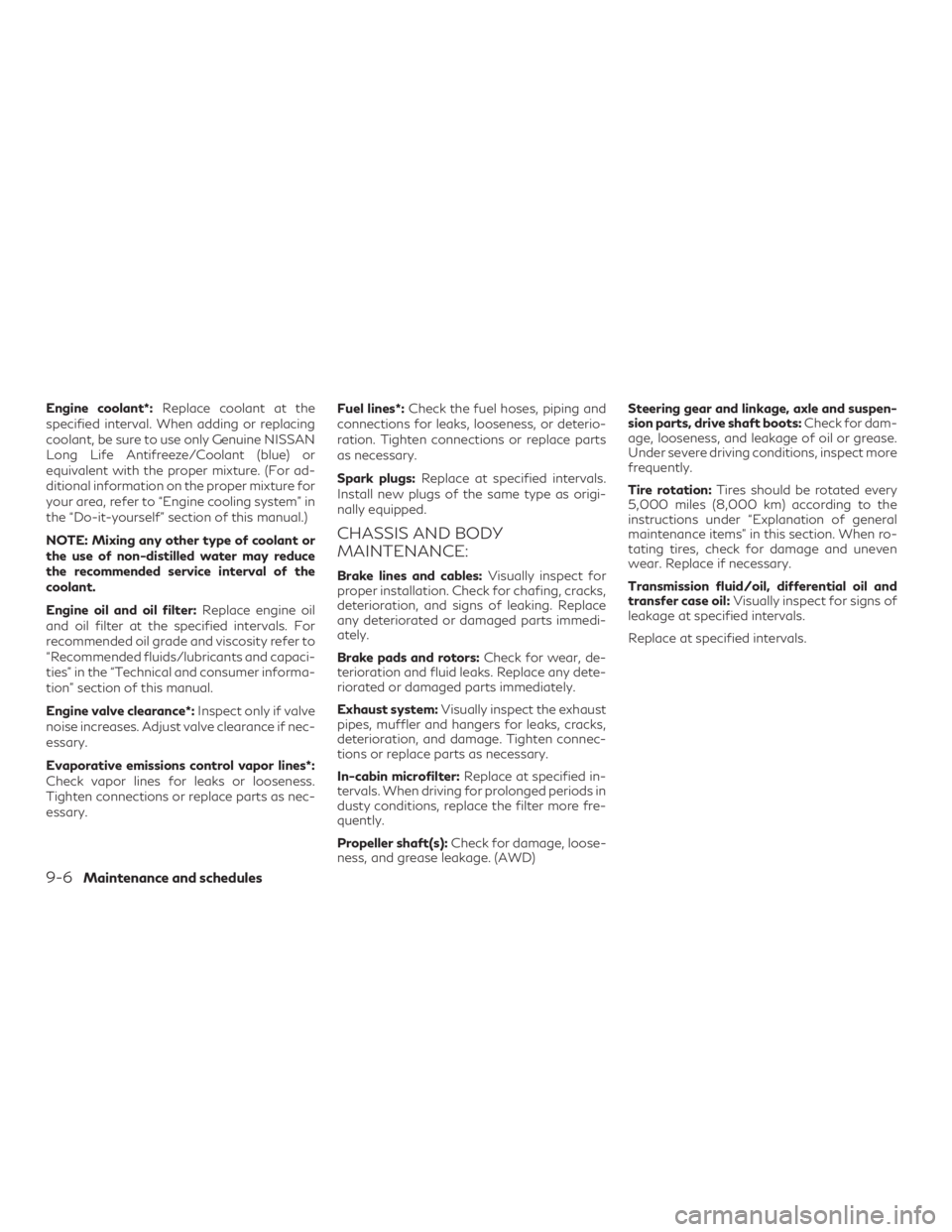
Engine coolant*:Replace coolant at the
specified interval. When adding or replacing
coolant, be sure to use only Genuine NISSAN
Long Life Antifreeze/Coolant (blue) or
equivalent with the proper mixture. (For ad-
ditional information on the proper mixture for
your area, refer to “Engine cooling system” in
the “Do-it-yourself” section of this manual.)
NOTE: Mixing any other type of coolant or
the use of non-distilled water may reduce
the recommended service interval of the
coolant.
Engine oil and oil filter: Replace engine oil
and oil filter at the specified intervals. For
recommended oil grade and viscosity refer to
“Recommended fluids/lubricants and capaci-
ties” in the “Technical and consumer informa-
tion” section of this manual.
Engine valve clearance*: Inspect only if valve
noise increases. Adjust valve clearance if nec-
essary.
Evaporative emissions control vapor lines*:
Check vapor lines for leaks or looseness.
Tighten connections or replace parts as nec-
essary. Fuel lines*:
Check the fuel hoses, piping and
connections for leaks, looseness, or deterio-
ration. Tighten connections or replace parts
as necessary.
Spark plugs: Replace at specified intervals.
Install new plugs of the same type as origi-
nally equipped.
CHASSIS AND BODY
MAINTENANCE:
Brake lines and cables: Visually inspect for
proper installation. Check for chafing, cracks,
deterioration, and signs of leaking. Replace
any deteriorated or damaged parts immedi-
ately.
Brake pads and rotors: Check for wear, de-
terioration and fluid leaks. Replace any dete-
riorated or damaged parts immediately.
Exhaust system: Visually inspect the exhaust
pipes, muffler and hangers for leaks, cracks,
deterioration, and damage. Tighten connec-
tions or replace parts as necessary.
In-cabin microfilter: Replace at specified in-
tervals. When driving for prolonged periods in
dusty conditions, replace the filter more fre-
quently.
Propeller shaft(s): Check for damage, loose-
ness, and grease leakage. (AWD) Steering gear and linkage, axle and suspen-
sion parts, drive shaft boots:
Check for dam-
age, looseness, and leakage of oil or grease.
Under severe driving conditions, inspect more
frequently.
Tire rotation: Tires should be rotated every
5,000 miles (8,000 km) according to the
instructions under “Explanation of general
maintenance items” in this section. When ro-
tating tires, check for damage and uneven
wear. Replace if necessary.
Transmission fluid/oil, differential oil and
transfer case oil: Visually inspect for signs of
leakage at specified intervals.
Replace at specified intervals.
9-6Maintenance and schedules
Page 484 of 540
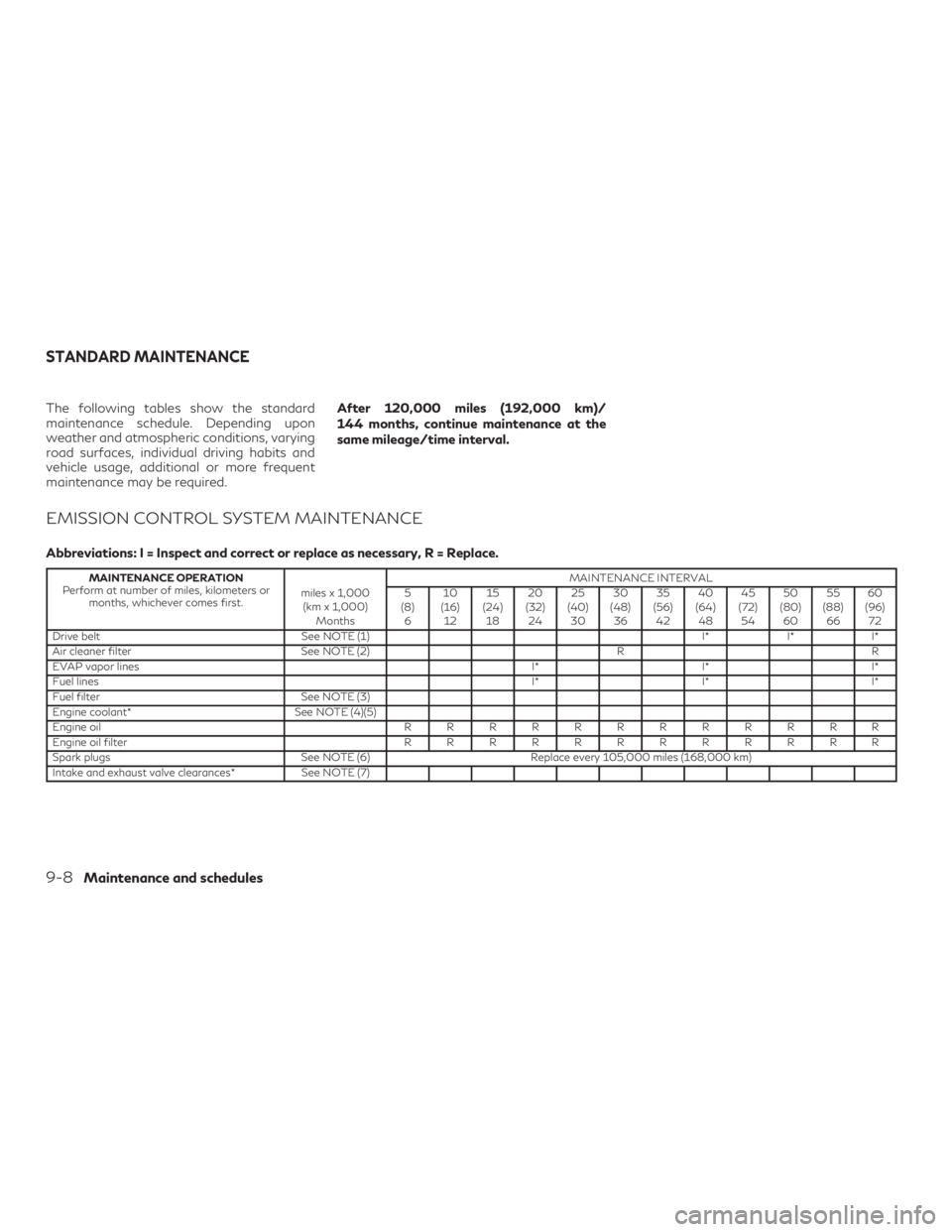
The following tables show the standard
maintenance schedule. Depending upon
weather and atmospheric conditions, varying
road surfaces, individual driving habits and
vehicle usage, additional or more frequent
maintenance may be required.After 120,000 miles (192,000 km)/
144 months, continue maintenance at the
same mileage/time interval.
EMISSION CONTROL SYSTEM MAINTENANCE
Abbreviations: I = Inspect and correct or replace as necessary, R = Replace.
MAINTENANCE OPERATION
Perform at number of miles, kilometers or months, whichever comes first. miles x 1,000
(km x 1,000) Months MAINTENANCE INTERVAL
5
(8) 6 10
(16) 12 15
(24) 18 20
(32) 24 25
(40) 30 30
(48) 36 35
(56) 42 40
(64) 48 45
(72) 54 50
(80) 60 55
(88) 66 60
(96) 72
Drive belt See NOTE (1) I*I*I*
Air cleaner filter See NOTE (2) RR
EVAP vapor lines I*I*I*
Fuel lines I*I*I*
Fuel filter See NOTE (3)
Engine coolant* See NOTE (4)(5)
Engine oil RRRRRRRRRRRR
Engine oil filter RRRRRRRRRRRR
Spark plugs See NOTE (6)Replace every 105,000 miles (168,000 km)
Intake and exhaust valve clearances* See NOTE (7)
STANDARD MAINTENANCE
9-8Maintenance and schedules
Page 485 of 540
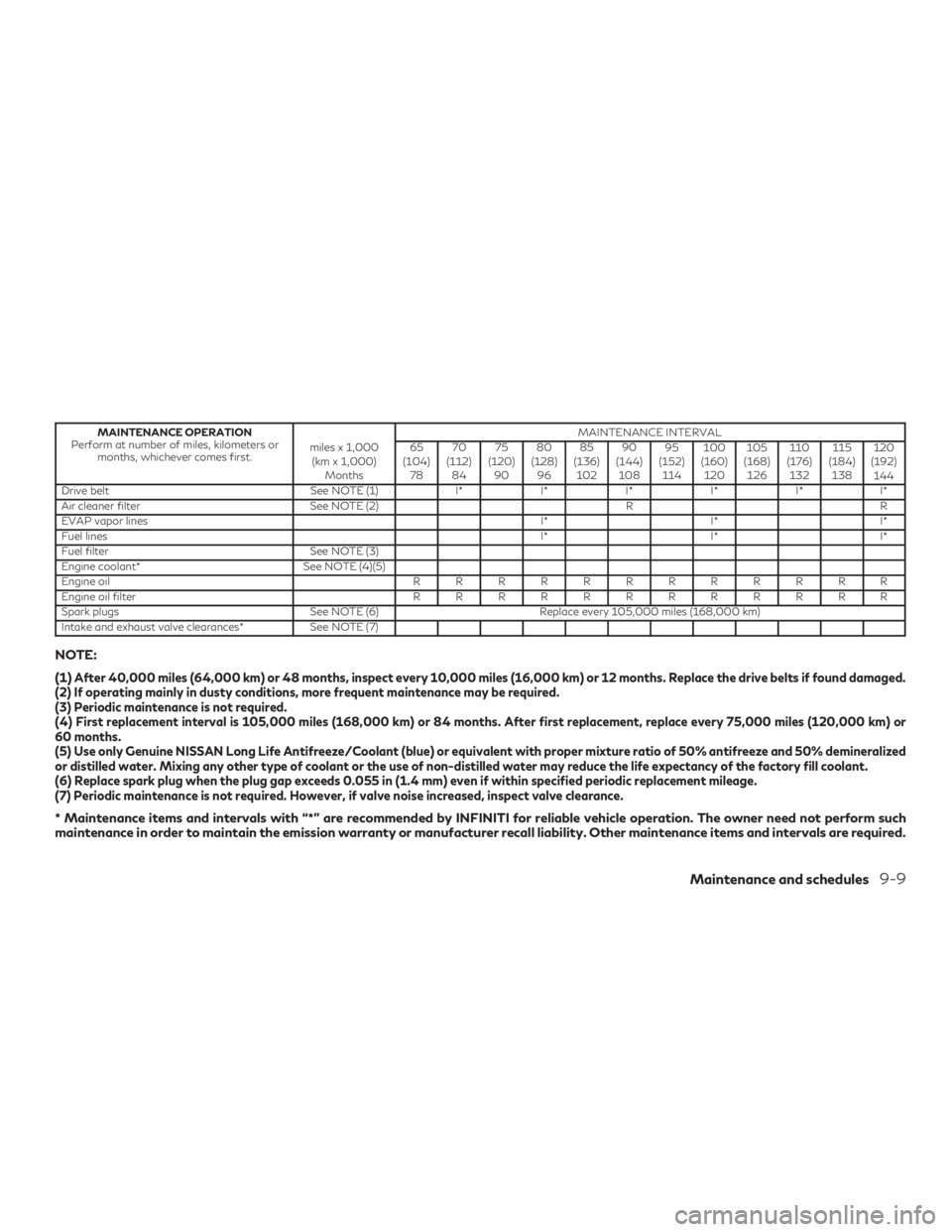
MAINTENANCE OPERATION
Perform at number of miles, kilometers or months, whichever comes first. miles x 1,000
(km x 1,000) Months MAINTENANCE INTERVAL
65
(104) 78 70
(112) 84 75
(120) 90 80
(128) 96 85
(136) 102 90
(144) 108 95
(152) 114 100
(160) 120 105
(168) 126 110
(176) 132 115
(184) 138 120
(192) 144
Drive belt See NOTE (1)I*I*I*I*I*I*
Air cleaner filter See NOTE (2) RR
EVAP vapor lines I*I*I*
Fuel lines I*I*I*
Fuel filter See NOTE (3)
Engine coolant* See NOTE (4)(5)
Engine oil RRRRRRRRRRRR
Engine oil filter RRRRRRRRRRRR
Spark plugs See NOTE (6)Replace every 105,000 miles (168,000 km)
Intake and exhaust valve clearances* See NOTE (7)
NOTE:
(1)
After 40,000 miles (64,000 km) or 48 months, inspect every 10,000 miles (16,000 km) or 12 months. Replace the drive belts if found damaged.
(2) If operating mainly in dusty conditions, more frequent maintenance may be required.
(3) Periodic maintenance is not required.
(4) First replacement interval is 105,000 miles (168,000 km) or 84 months. After first replacement, replace every 75,000 miles (120,000 km) or
60 months.
(5) Use only Genuine NISSAN Long Life Antifreeze/Coolant (blue) or equivalent with proper mixture ratio of 50% antifreeze and 50% demineralized
or distilled water. Mixing any other type of coolant or the use of non-distilled water may reduce the life expectancy of the factory fill coolant.
(6) Replace spark plug when the plug gap exceeds 0.055 in (1.4 mm) even if within specified periodic replacement mileage.
(7) Periodic maintenance is not required. However, if valve noise increased, inspect valve clearance.
* Maintenance items and intervals with “*” are recommended by INFINITI for reliable vehicle operation. The owner need not perform such
maintenance in order to maintain the emission warranty or manufacturer recall liability. Other maintenance items and intervals are required.
Maintenance and schedules9-9
Page 493 of 540
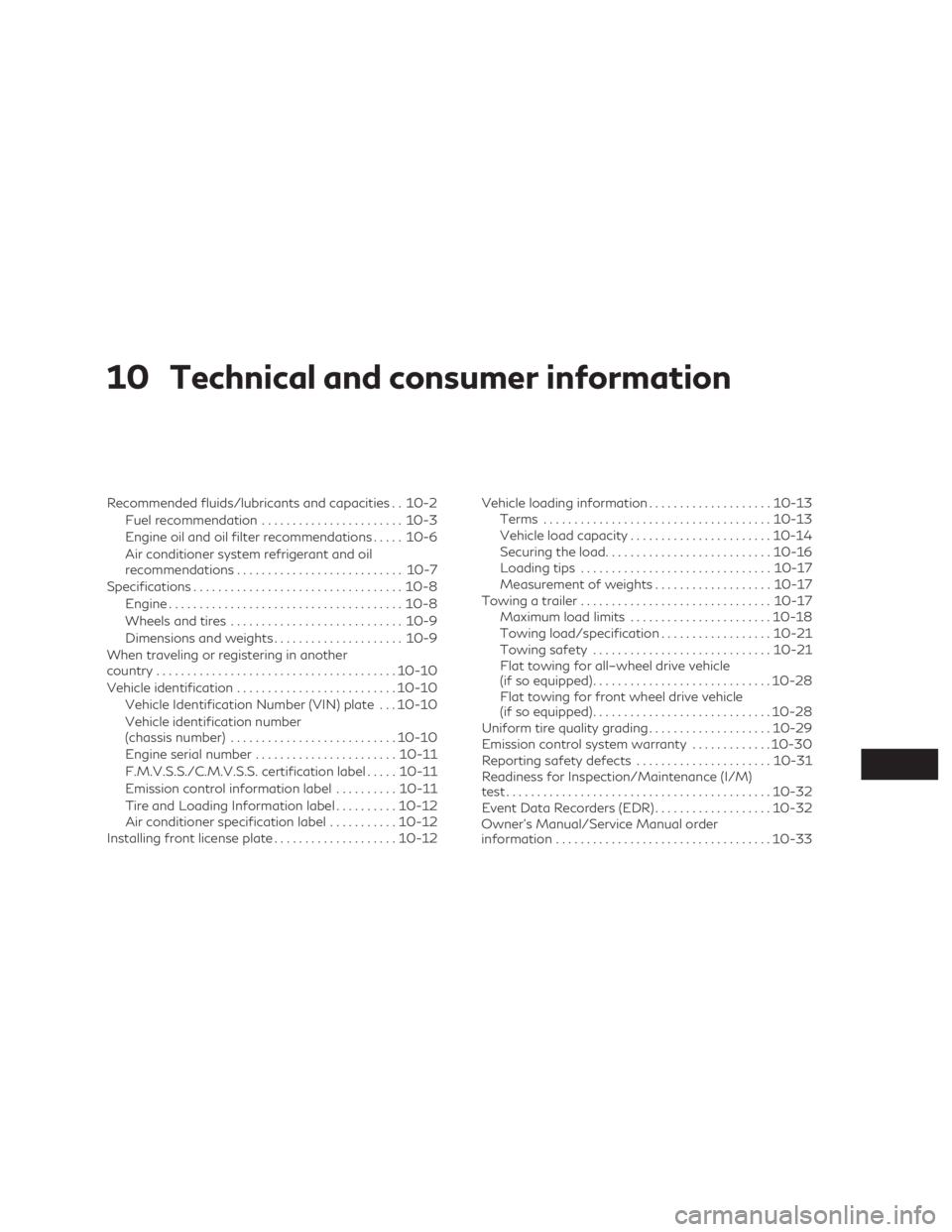
10 Technical and consumer information
Recommended fluids/lubricants and capacities . . 10-2Fuel recommendation ....................... 10-3
Engine oil and oil filter recommendations .....10-6
Air conditioner system refrigerant and oil
recommendations ........................... 10-7
Specifications .................................. 10-8
Engine ...................................... 10-8
Wheels and tires ............................ 10-9
Dimensions and weights .....................10-9
When traveling or registering in another
country ....................................... 10-10
Vehicle identification .......................... 10-10
Vehicle Identification Number (VIN) plate . . . 10-10
Vehicle identification number
(chassis number) ........................... 10-10
Engine serial number ....................... 10-11
F.M.V.S.S./C.M.V.S.S. certification label .....10-11
Emission control information label ..........10-11
Tire and Loading Information label ..........10-12
Air conditioner specification label ...........10-12
Installing front license plate ....................10-12Vehicle loading information
....................10-13
Terms ..................................... 10-13
Vehicle load capacity ....................... 10-14
Securing the load ........................... 10-16
Loading tips ............................... 10-17
Measurement of weights ...................10-17
Towing a trailer ............................... 10-17
Maximum load limits ....................... 10-18
Towing load/specification ..................10-21
Towing safety ............................. 10-21
Flat towing for all–wheel drive vehicle
(if so equipped) ............................. 10-28
Flat towing for front wheel drive vehicle
(if so equipped) ............................. 10-28
Uniform tire quality grading ....................10-29
Emission control system warranty .............10-30
Reporting safety defects ......................10-31
Readiness for Inspection/Maintenance (I/M)
test ........................................... 10-32
Event Data
Recorders (EDR) ................... 10-32
Owner’s Manual/Service Manual order
information ................................... 10-33
Page 494 of 540
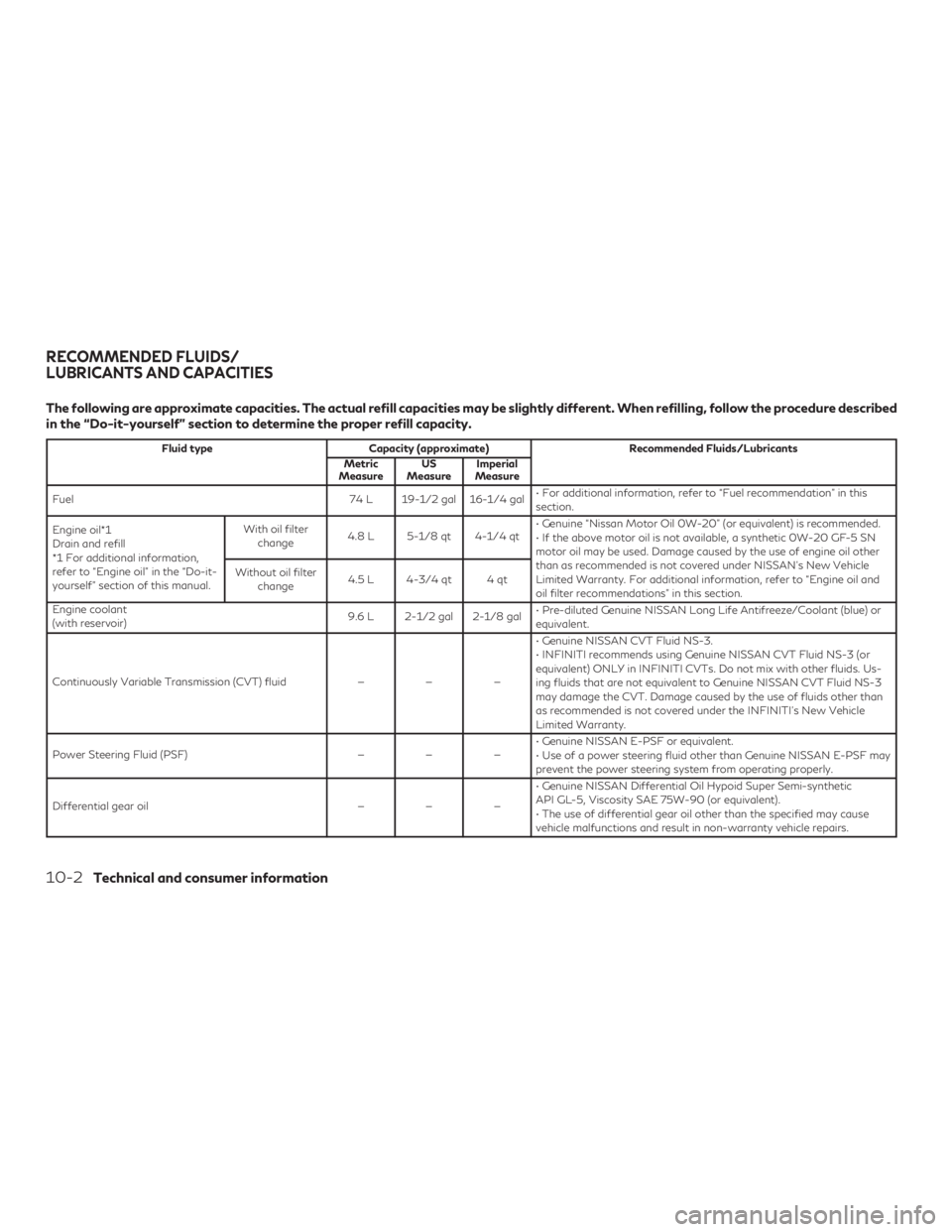
The following are approximate capacities. The actual refill capacities may be slightly different. When refilling, follow the procedure described
in the “Do-it-yourself” section to determine the proper refill capacity.
Fluid typeCapacity (approximate) Recommended Fluids/Lubricants
Metric
Measure US
Measure Imperial
Measure
Fuel 74 L 19-1/2 gal 16-1/4 gal• For additional information, refer to “Fuel recommendation” in this
section.
Engine oil*1
Drain and refill
*1 For additional information,
refer to “Engine oil” in the “Do-it-
yourself” section of this manual. With oil filter
change 4.8 L 5-1/8 qt 4-1/4 qt • Genuine “Nissan Motor Oil 0W-20” (or equivalent) is recommended.
• If the above motor oil is not available, a synthetic 0W-20 GF-5 SN
motor oil may be used. Damage caused by the use of engine oil other
than as recommended is not covered under NISSAN’s New Vehicle
Limited Warranty. For additional information, refer to “Engine oil and
oil filter recommendations” in this section.
Without oil filter
change 4.5 L 4-3/4 qt 4 qt
Engine coolant
(with reservoir) 9.6 L 2-1/2 gal 2-1/8 gal
• Pre-diluted Genuine NISSAN Long Life Antifreeze/Coolant (blue) or
equivalent.
Continuously Variable Transmission (CVT) fluid ———• Genuine NISSAN CVT Fluid NS-3.
• INFINITI recommends using Genuine NISSAN CVT Fluid NS-3 (or
equivalent) ONLY in INFINITI CVTs. Do not mix with other fluids. Us-
ing fluids that are not equivalent to Genuine NISSAN CVT Fluid NS-3
may damage the CVT. Damage caused by the use of fluids other than
as recommended is not covered under the INFINITI’s New Vehicle
Limited Warranty.
Power Steering Fluid (PSF) ———• Genuine NISSAN E-PSF or equivalent.
• Use of a power steering fluid other than Genuine NISSAN E-PSF may
prevent the power steering system from operating properly.
Differential gear oil ———• Genuine NISSAN Differential Oil Hypoid Super Semi-synthetic
API GL-5, Viscosity SAE 75W-90 (or equivalent).
• The use of differential gear oil other than the specified may cause
vehicle malfunctions and result in non-warranty vehicle repairs.
RECOMMENDED FLUIDS/
LUBRICANTS AND CAPACITIES
10-2Technical and consumer information
Page 496 of 540

∙ Do not use a fuel containing more than15% ethanol in your vehicle. Your vehicle
is not designed to run on a fuel containing
more than 15% ethanol. Using a fuel con-
taining more than 15% ethanol in a ve-
hicle not specifically designed for a fuel
containing more than 15% ethanol can
adversely affect the emission control de-
vices and systems of the vehicle. Damage
caused by such fuel is not covered by the
INFINITI New Vehicle Limited Warranty.
∙ Do not use fuel that contains the octane booster methylcyclopentadienyl manga-
nese tricarbonyl (MMT). Using fuel con-
taining MMT may adversely affect ve-
hicle performance and vehicle emissions.
Not all fuel dispensers are labeled to indi-
cate MMT content, so you may have to
consult your gasoline retailer for more
details. Note that Federal and California
laws prohibit the use of MMT in reformu-
lated gasoline.
∙ U.S. government regulations require ethanol dispensing pumps to be identi-
fied by a small, square, orange and black
label with the common abbreviation or
the appropriate percentage for that
region.Gasoline specifications
INFINITI recommends using gasoline that
meets the World-Wide Fuel Charter
(WWFC) specifications where it is available.
Many of the automobile manufacturers de-
veloped this specification to improve emis-
sion control system and vehicle performance.
Ask your service station manager if the gaso-
line meets the WWFC specifications.
Reformulated gasoline
Some fuel suppliers are now producing refor-
mulated gasolines. These gasolines are spe-
cially designed to reduce vehicle emissions.
INFINITI supports efforts towards cleaner air
and suggests that you use reformulated
gasoline when available.
Gasoline containing oxygenates
Some fuel suppliers sell gasoline containing
oxygenates such as ethanol, MTBE and
methanol with or without advertising their
presence. INFINITI does not recommend the
use of fuels of which the oxygenate content
and the fuel compatibility for your INFINITI
cannot be readily determined. If in doubt, ask
your service station manager. If you use oxygenate-blend gasoline, please
take the following precautions as the usage
of such fuels may cause vehicle performance
problems and/or fuel system damage.
∙ The fuel should be unleaded and have an
octane rating no lower than that recom-
mended for unleaded gasoline.
∙ If an oxygenate-blend other than
methanol blend is used, it should contain
no more than 15% oxygenate.
∙ If a methanol blend is used, it should con-
tain no more than 5% methanol (methyl
alcohol, wood alcohol). It should also
contain a suitable amount of appropri-
ate cosolvents and corrosion inhibitors.
If not properly formulated with appro-
priate cosolvents and corrosion inhibi-
tors, such methanol blends may cause
fuel system damage and/or vehicle per-
formance problems. At this time, suffi-
cient data is not available to ensure that
all methanol blends are suitable for use in
INFINITI vehicles.
If any driveability problems such as engine
stalling and difficult hot-starting are experi-
enced after using oxygenate-blend fuels, im-
mediately change to a non-oxygenate fuel or
a fuel with a low blend of MTBE.
10-4Technical and consumer information
Page 497 of 540
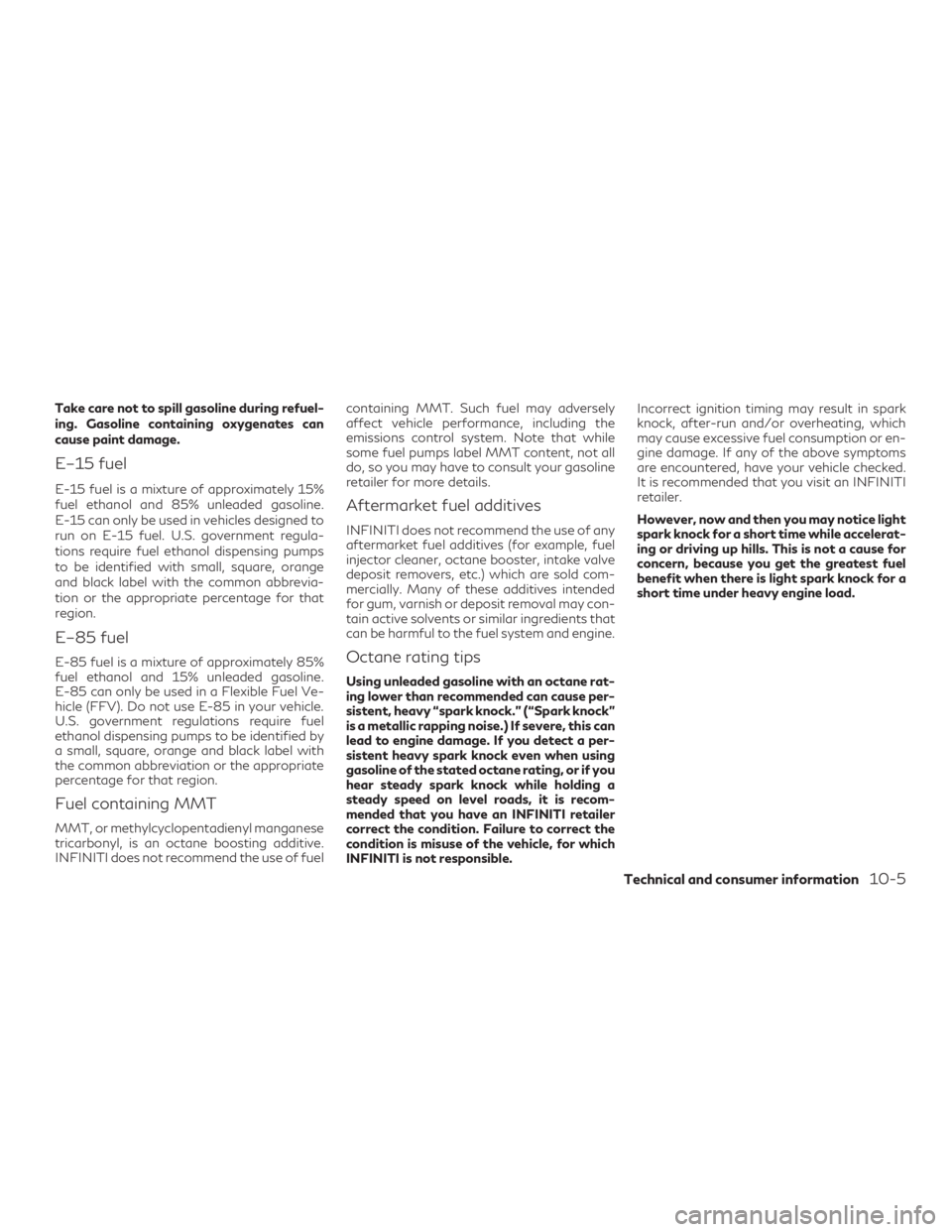
Take care not to spill gasoline during refuel-
ing. Gasoline containing oxygenates can
cause paint damage.
E–15 fuel
E-15 fuel is a mixture of approximately 15%
fuel ethanol and 85% unleaded gasoline.
E-15 can only be used in vehicles designed to
run on E-15 fuel. U.S. government regula-
tions require fuel ethanol dispensing pumps
to be identified with small, square, orange
and black label with the common abbrevia-
tion or the appropriate percentage for that
region.
E–85 fuel
E-85 fuel is a mixture of approximately 85%
fuel ethanol and 15% unleaded gasoline.
E-85 can only be used in a Flexible Fuel Ve-
hicle (FFV). Do not use E-85 in your vehicle.
U.S. government regulations require fuel
ethanol dispensing pumps to be identified by
a small, square, orange and black label with
the common abbreviation or the appropriate
percentage for that region.
Fuel containing MMT
MMT, or methylcyclopentadienyl manganese
tricarbonyl, is an octane boosting additive.
INFINITI does not recommend the use of fuelcontaining MMT. Such fuel may adversely
affect vehicle performance, including the
emissions control system. Note that while
some fuel pumps label MMT content, not all
do, so you may have to consult your gasoline
retailer for more details.
Aftermarket fuel additives
INFINITI does not recommend the use of any
aftermarket fuel additives (for example, fuel
injector cleaner, octane booster, intake valve
deposit removers, etc.) which are sold com-
mercially. Many of these additives intended
for gum, varnish or deposit removal may con-
tain active solvents or similar ingredients that
can be harmful to the fuel system and engine.
Octane rating tips
Using unleaded gasoline with an octane rat-
ing lower than recommended can cause per-
sistent, heavy “spark knock.” (“Spark knock”
is a metallic rapping noise.) If severe, this can
lead to engine damage. If you detect a per-
sistent heavy spark knock even when using
gasoline of the stated octane rating, or if you
hear steady spark knock while holding a
steady speed on level roads, it is recom-
mended that you have an INFINITI retailer
correct the condition. Failure to correct the
condition is misuse of the vehicle, for which
INFINITI is not responsible.Incorrect ignition timing may result in spark
knock, after-run and/or overheating, which
may cause excessive fuel consumption or en-
gine damage. If any of the above symptoms
are encountered, have your vehicle checked.
It is recommended that you visit an INFINITI
retailer.
However, now and then you may notice light
spark knock for a short time while accelerat-
ing or driving up hills. This is not a cause for
concern, because you get the greatest fuel
benefit when there is light spark knock for a
short time under heavy engine load.
Technical and consumer information10-5
Page 498 of 540

ENGINE OIL AND OIL FILTER
RECOMMENDATIONS
Selecting the correct oil
It is essential to choose the correct grade,
quality and viscosity engine oil to ensure sat-
isfactory engine life and performance. For
additional information, refer to "Recom-
mended fluids/lubricants and capacities" in
this section. INFINITI recommends the use of
an energy conserving oil in order to improve
fuel economy.Select only engine oils that meet the Ameri-
can Petroleum Institute (API) certification or
International Lubricant Standardization and
Approval Committee (ILSAC) certification
and SAE viscosity standard. These oils have
the API certification mark on the front of the
container. Oils which do not have the speci-
fied quality label should not be used as they
could cause engine damage.
Oil additives
INFINITI does not recommend the use of oil
additives. The use of an oil additive is not
necessary when the proper oil type is used
and maintenance intervals are followed.Oil which may contain foreign matter or has
been previously used should not be used.
Oil viscosity
The engine oil viscosity or thickness changes
with temperature. Because of this, it is impor-
tant to select the engine oil viscosity based on
the temperatures at which the vehicle will be
operated before the next oil change. Choos-
ing an oil viscosity other than that recom-
mended could cause serious engine damage.
Selecting the correct oil filter
Your new INFINITI vehicle is equipped with a
high-quality Genuine NISSAN oil filter. When
replacing, use a Genuine NISSAN oil filter or
its equivalent for the reason described in
“Change intervals”.
Change intervals
The oil and oil filter change intervals for your
engine are based on the use of the specified
quality oils and filters. Using engine oil and
filters that are not of the specified quality, or
exceeding recommended oil and filter change
intervals could reduce engine life. Damage to
the engine caused by improper maintenance
or use of incorrect oil and filter quality and/or
viscosity is not covered by the INFINITI New
Vehicle Limited Warranty.
LTI2051
10-6Technical and consumer information